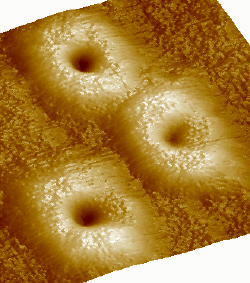The Smallest Rings of Electricity

In most quantum systems, an electron in the ground state has no preferred direction, as in the spherical “1s” orbital of an electron in a hydrogen atom. But adding a magnetic field can change that. An electron confined to a wire ring in a magnetic field zips around at high speed in only one direction, even in its lowest energy state. This effect has now been verified in the 6 March PRL, using the smallest rings ever to support measurable currents. Only 50 nm across, the rings act like pure quantum systems of one or two confined electrons, allowing researchers to study the behavior of electrons in a new and controlled way. They may also lead to digital data storage devices in the future.
Quantum dots are microscopic, carefully tailored regions of a semiconductor surface in which researchers have learned to precisely control the number of electrons and observe a range of quantum effects. Some hope to use them to store bits in future quantum computers. One way to make many dots at once is to spray two atomic layers of InAs on a GaAs surface. Surface tension forces the InAs into beads, like water droplets on a well-waxed car, forming as many as so-called self-assembled quantum dots. Axel Lorke and his colleagues at the Ludwig Maximilians University in Munich and collaborators at the University of California in Santa Barbara (UCSB) managed to make rings from such structures by capping the dots with a 1-nm-thick layer of GaAs and waiting a minute, as surface tension and other forces rearranged the dots. Afterward, each dot looks “a little bit like an atoll,” says Pierre Petroff, leader of the UCSB group.
Lorke says that simply making the ring-shaped islands is an important step, demonstrating to skeptics that self-assembled dots are not doomed from the lack of control over shape. He and his colleagues showed the pure quantum nature of electrons in the tiny rings with two different types of measurements.
In the first, they placed the array of rings between the equivalent of a pair of metallic plates and increased the voltage between them until exactly one conduction electron, on average, jumped to each ring from one of the plates, as determined by capacitance. That voltage gave the electron’s ground state energy, which increased predictably as the team increased the magnetic field piercing the rings. But when the field reached one quantum of magnetic flux per ring (about 8 T), a sudden change in the ground state energies indicated new properties of the ground state–in this case, the electron had one unit of angular momentum in a specific direction, rather than circulating clockwise and counterclockwise equally. In the second measurement, the team showed that the array of rings absorbed infrared photons with the right energies to allow transitions between the magnetic-field-dependent quantum states they predicted.
The minute rings allow one or two electrons to circulate in coherent quantum states, without the complications such as electron scattering that have occurred in experiments with larger rings, says Sergio Ulloa of Ohio University in Athens. He is impressed that the structures provide a “very clean” system for studying several issues that theorists have discussed, but for which no good experimental system existed. Ulloa adds that one could imagine storing bits of data with these rings, where 1’s and 0’s would be distinguished by the direction of circulation of single electrons, although “this is of course blue sky,” he cautions–a far-off application.


